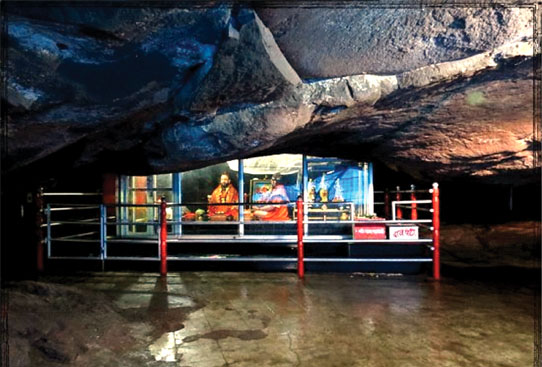Temple and its surroundings are not merely a place of worship. It is a space to be felt and experienced through all the five senses. After entering the temple, one should automatically bow before the idol due to the atmosphere and peace and serenity
-Dr Ujwala Chakradeo

Sundarmath of Shitharghal is one of important Kshetras
with spiritual and historical significance
with spiritual and historical significance
Shivtharghal is a cave in Raigad district of Maharashtra. It is 34-kilometres away from Mahad. ‘Ghal’ means cave. It is surrounded by high mountains on all sides and is situated at the foot of the Waghjai valley. Shivtharghal is in the midst of the mountains, covered with green trees and vines. Samarth called it ‘Sundar Math’. Samarth Ramdas Swami (seventeenth century) lived here for 22 years. During this time, Samarth wrote ‘Dasbodh’, his famous treatise. Dasbodh loosely means ‘advice to the disciple’ in Marathi. This is a spiritual text. His disciple Kalyan Swami assisted him in this writing. How did he find out about this cave?
What was so special about this place that made him stay there for so long? Samarth always said that the place is very peaceful and one needs to be pure-hearted to be able to enjoy the place. Harmony of the place flows deep within, touching the soul of every visitor. The temptation to be there forever is universal.
We are aware that devices with GPS (global positioning system) can detect satellite waves of the space. But it has been observed that right from the entrance of this cave all such instruments are disabled and become non-functional, imparting absolute peace and tranquillity to the inmates. How and why no one does this happen knows. The scientific inventions of this kind are a recent phenomenon. On which parameters did Samarth Ramdas Swami decide to live there? Is today’s science advanced enough to determine the suitability of those parameters?
Shivtharghal is just an example presented as an icon of all those places in Bharat where the existence of ‘GOD’ is experienced and these places which have been designated as ‘teerth kshetra’.
Architects then knew that the surrounding environment had a profound impact on the mind. Therefore, the place for creating such an environment was also chosen very carefully.
In contrast, numerous temples nowadays are seen at every nook and corner of the road. What happens to the serenity and calmness needed for the worship in these temples? This is the challenge for today’s designers. Sentiments of Bhaktas ensure the flow of appropriate emotions to nurture the desired quality spaces and supports sensitive temple design.
(The columnist is Principal of SMM College of Architecture, Nagpur and specialises in Bharatiya Architectural Heritage)














Comments